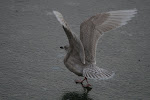I've recently been going through my photos for an up and coming presentation I am giving to Bangor Bird Group.
Anyway, I remember learning an awful lot about Reed Buntings whilst I was there as we caught 169 during my visit.
I came across some photos of juvenile birds and thought it might be interesting to show a few sexing features of juvenile Reed Buntings before/during post-juvenile moult.
Juvenile Female
This bird is undergoing post juvenile moult into 1st winter plumage. The growing tail feathers show the adult-like broad rounded tips to the feathers, whereas the fully grown unmoulted tail feathers are relatively thin and pointed. This shows it to be a juvenile bird.
The mantle here is one of the key features for sexing. This shows subtle pale tramlines just off centre and the rest of the brown feathers is fairly pale and soft brown. In addition, the black streaking is quite diffuse and thin.
Next we have the pattern of the greater coverts and lesser coverts for identification of female. The rufous fringing to the greater coverts are really broad and the lesser coverts are the same colour being not especially rufous at all. Finally you'll note the tertials have a very pale flash to the fringing.
Juvenile Male
Ok, so now we move onto the male. Everything about the male is more rufous and more bold.
The mantle shows much bolder black streaking, with the paler feathering being much more rufous than the female. The fringing to the greater coverts is much narrower than on the female, plus the lesser coverts are very rufous indeed. Finally, the fringing to the tertials is rufous and brown with no real hint of any cream/white fringing.
Just a small blog post with a couple of features that you may already be aware of, but if not, hope you enjoyed it.




No comments:
Post a Comment